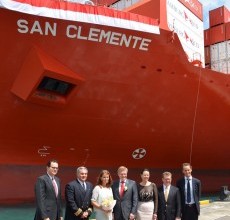 German container liner Hamburg Sud recently christened the third in a series of three box ships in its “San” class in Singapore.
German container liner Hamburg Sud recently christened the third in a series of three box ships in its “San” class in Singapore.
The official naming ceremony for the “San Clemente,” which is the last of Hamburg Sud’s three “San” class newbuilds constructed at the Korean shipyard Hyundai Heavy Industries in Ulsan, was conducted at the Marina Bay Cruise Center in Singapore.
Like her sister ships, the San Clemente has a container slot capacity of 9,034 twenty-foot-equivalent units (TEUs) and 1,370 reefer slots. It is operating on the service between Asia and the East coast of South America together with the “San Christobal,” which was christened in August.
Hamburg Sud took delivery of the third newbuild, the “San Vicente,” a week ago.
The San Clemente has a capacity of 111,700 total deadweight, and measures 300 meters in length and 48.2 meters in width.
Maersk Line’s mega plans
Meanwhile, Danish shipping company Maersk Line is said to be considering buying more Triple-E vessels when it pushes through with plans to place multimillion-dollar ship orders over the next six months.
Maersk Line, the world’s biggest container shipping firm, said most of its proposed orders over the next three years will be for big ships that may include Triple-E vessels.
The plan to buy more giant ships comes even as the container shipping industry has been struggling with overcapacity that has led to falling freight rates on the major trade lanes particularly between the east and west, because mega ships are viewed as being more cost efficient than smaller types when fully loaded.
The Triple-E class is today the world’s largest and most efficient vessel type, capable of carrying more than 18,000 TEUs.
Maersk Line previously ordered 20 Triple-E vessels in 2011. This has since triggered similar orders for ultra-large container vessels among the liner’s competitors, as players battle for survival and control of the high seas by relying on economies of scale and forming alliances with rivals.
This buying and sharing of big ships is also seen as a long-term strategy to slowly muscle out smaller carriers from the mighty Asia-Europe trades, thus creating more balance to the supply-demand ratio that will enable the carriers to raise freight rates.




